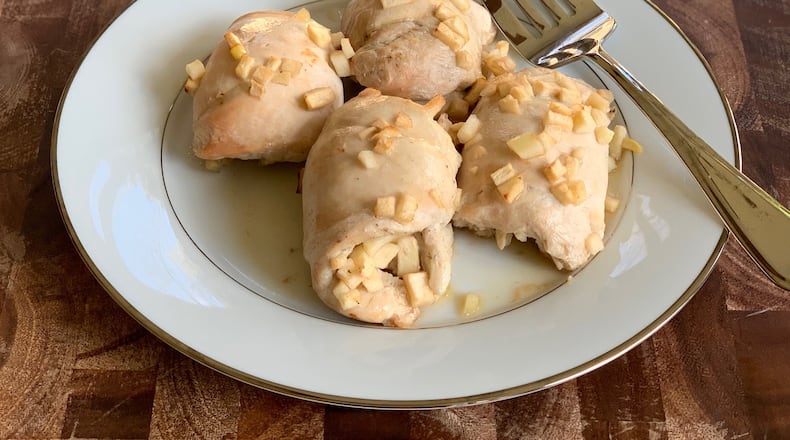Charoset, pronounced ha-ROH-set, is a mixture of fruits and nuts that is a staple of traditional Passover dinners. The specific ingredients tend to vary along geographic lines. My Ashkenazi Jewish family makes our charoset like a fruit salsa, using chopped raw apples, walnuts and honey. But if you celebrate in a Sephardic Jewish home, the charoset may resemble a paste made from blended dates and figs. No matter which recipe you use, I promise that charoset will be the most universally appealing dish on the Passover table. (Gefilte fish, I’m looking sideways at you.)
In fact, charoset is so tasty that I hate to see it go to waste after the festive meals are finished. If you are well-versed in the rules of Passover baking, you can mix charoset into your favorite cookie or bar recipes for an easy, sweet treat. Alternatively, charoset can turn boneless, skinless chicken breasts, a weeknight dinner staple for people of many faiths, into something special.
Start by making your charoset. I recommend using a Granny Smith apple, because we will be baking the charoset in our chicken breasts. But if you have only red apples, and don’t mind a little crunch, a non-baking apple is just fine. I skip the walnuts because of my husband’s nut allergy; feel free to do the same if you have similar concerns. Splashes of lemon juice, honey and sweet red wine round out the flavors. Don’t keep a bottle of sweet red in stock? A splash of grape juice will work just as well.
Now listen up, because this is the only part of the recipe that you can’t wing: You must take a few minutes to pound the chicken breasts flat before wrapping them around the charoset. A thick, loaded chicken breast will not cook evenly and thoroughly, and that’s just not kosher. If you don’t have the time or inclination to flatten the chicken, forget the whole “stuffed” part and simply bake your chicken with the charoset spooned on top.
Your cook time will vary with the weight of the individual chicken breasts. My ginormous Costco fillets needed a generous 40 minutes, but the daintier fillets from Whole Foods cooked up in barely half an hour. Because there’s a plethora of sizes, it’s safest to use a meat thermometer, rather than a timer, to determine doneness.
If there is a universal concern about boneless, skinless chicken breasts, it’s that they dry out when baked in the oven. And that’s exactly what happened with my test recipes, even though there is plenty of liquid in the charoset. The solution? Tuck a piece of parchment paper over the top of the chicken before you bake it. The parchment paper preserves the juices in the baking dish, infusing the chicken with moisture and apple-y goodness. It’s a game-changing trick that works for any baked chicken breast recipe, and is the answer to this home cook’s prayers.
RELATED:
Read more stories like this by liking Atlanta Restaurant Scene on Facebook, following @ATLDiningNews on Twitter and @ajcdining on Instagram.
About the Author
Keep Reading
The Latest
Featured



